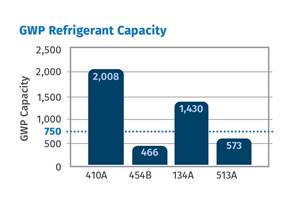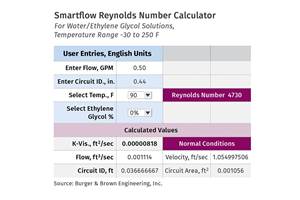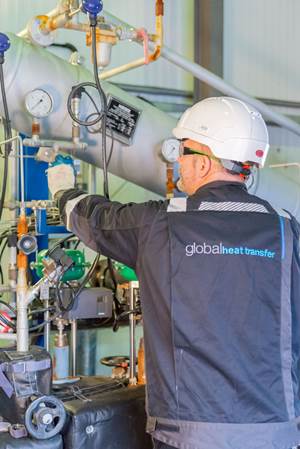Air-Ring Upgrade Pumps Up the Output
Film processor Dallas Plastics boosts throughput by as much as 40% by retrofitting a new air ring—without the need for IBC.
Output increases equal to that of adding internal bubble cooling without the “expense and headaches” associated with IBC. That’s how Miguel Sanchez described his experience following the installation of a new air ring at Dallas Plastics Corp.’s blown-film plant in Wentzville, Mo.
Sanchez manages that plant, one of three facilities operated by Dallas Plastics, which was established in 1989. The company specializes in converter-grade films for printing, laminating, and automated packaging, and offers a wide range of specialty films such as narrow-width lay-flat tubing, critical-tolerance films, non-scratch LDPE, and high-tensile-draw tape for drawstring bags. Its films are used in a wide variety of markets that include food, medical, agricultural, retail, automotive, aircraft, and electronics.
In Missouri, Dallas Plastics runs 24:7 on 12 monolayer lines that range in size from 3/4.-in. to 12-in. die diam. Film thickness ranges from 3/4 mil to 7 mils. Company-wide, Dallas Plastics runs layflat widths to 60 in., though Sanchez’s plant focuses more on small-size tubing. Dallas Plastics runs a wide range of LDPEs and blends of LDPE/EVA or LLDPE/EVA, the latter based on both hexene and metallocene technologies.
Like most PE film processors, Dallas Plastics is regularly on the lookout for technologies to increase capacity. Last year, it considered retrofitting IBC on some lines, but ruled it out because of cost.
“It’s not just the IBC system itself, but you have to invest in a new die that can accommodate the IBC, along with new blowers and other components,” says Sanchez. Instead, acting on a tip it received from a fellow film processor, Sanchez opted for a patent-pending air ring offered by Addex Inc., USA, Newark, N.Y.
Addex introduced the Intensive Cooling Air Ring in 2016. It utilizes up to four stacked cooling elements with a surrounding enclosure, all topped by a conventional air ring. But Addex quickly realized that this technology was probably better suited for brand-new lines, so at K 2016 it showed a scaled-down version specifically targeting the retrofit business.
Dallas Plastics’ $30,000 investment in a new air ring paid for itself in five months.
In the Intensive Cooling Air Ring, the standard lower lip on Addex’s dual-lip air rings is replaced with a single intensive-cooling element. As Addex explains, this transforms the previous low-velocity lower lip into a high-velocity air stream, creating two primary locking points instead of just one, to significantly improve bubble stability. The Intensive Cooling air rings also include all the secondary air-collar locking points of the original air-ring design, says Addex. The units are reported to be simple and operator friendly, allowing a broad range of processes, blow-up ratios, thicknesses, and materials with minimal adjustments.
Dallas Plastics ordered two of the new air rings, one for the Missouri plant and the other for its facility in Longview, Tex. In Missouri, the new ring was installed last May on a 10-in. die. Installation was fast and easy—“like putting on your socks,” Sanchez notes—and the $30,000 investment started paying off immediately.
Addex guarantees a 10-15% output bump, but Sanchez reports output gains of 15-20% on average, and up to 40% in some cases, depending on the resin blend, with no negative impact on film properties.
“The investment has already paid for itself,” Sanchez said in late November, roughly five months after the air ring was installed. Sanchez adds that Dallas Plastics has on order a third Intensive Cooling Air Ring, which will be installed early this year on a 12-in. line at its headquarters facility in Mesquite, Tex.
Related Content
Temperature Control: What You Need to Know to Comply With New Cooling-Fluid Regs
Beginning the first of this year, 12 states are following EPA bans on potentially damaging cooling fluids. Chiller suppliers have adjusted equipment designs to accommodate the new regulations. Here’s what all this means to processors.
Read MoreCooling Geometry and the Reynolds Calculation
The original Turbulent Flow Rate Calculator worked well with a round circuit diameter, such as a drilled passage, but not as well using hydraulic diameters. Here’s how the problem was fixed.
Read MoreHow to Reduce Sinks in Injection Molding
Modifications to the common core pin can be a simple solution, but don’t expect all resins to behave the same. Gas assist is also worth a try.
Read MoreFollow These Best Practices When Working With Heat Transfer Fluids
Effectively choosing, operating and maintaining thermal fluid can positively impact productivity in plastics processing.
Read MoreRead Next
Stackable Bubble-Cooling Rings Offer Huge Output Gains
Next-generation bubble-cooling system is said to boost throughputs by as much as 60% in blown film.
Read MoreAdvanced Recycling: Beyond Pyrolysis
Consumer-product brand owners increasingly see advanced chemical recycling as a necessary complement to mechanical recycling if they are to meet ambitious goals for a circular economy in the next decade. Dozens of technology providers are developing new technologies to overcome the limitations of existing pyrolysis methods and to commercialize various alternative approaches to chemical recycling of plastics.
Read MoreTroubleshooting Screw and Barrel Wear in Extrusion
Extruder screws and barrels will wear over time. If you are seeing a reduction in specific rate and higher discharge temperatures, wear is the likely culprit.
Read More


























